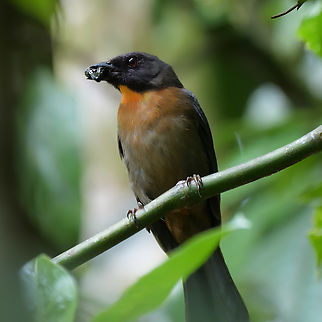
Appearance
Based on a small number of specimens, the black-cheeked ant tanager is 18 to 19 cm long and weighs 36.2 to 48.9 g. The male's upper parts are dark gray with a red tinge, and it has a orange-red crest. The face has a diffuse black "mask". The throat is bright salmon orange that transitions through darker salmon to dark gray with a pink tinge on the belly. The female is similar but duller and its crest is smaller.Distribution
The black-cheeked ant tanager is found only on Costa Rica's Osa Peninsula and the adjoining eastern shore of Golfo Dulce. inland.Status
The IUCN has assessed the black-cheeked ant tanager as near threatened "because of its small range which is mostly confined to two protected areas." "The primary threat to [the species] is ongoing fragmentation of lowland forest".Habitat
It inhabits well-developed understorey in lowland forest, riparian woodlands, and older secondary forest. It stays in the forest interior and shuns edges and open habitat. In elevation it ranges up to approximately 300 m.Reproduction
The black-cheeked ant tanager has been documented nesting between January and March. It builds an open cup nest fairly low in understorey vegetation. All known clutches were of two eggs. The species appears to nest cooperatively, as three adults have been documented attending nestlings.Food
The black-cheeked ant tanager is primarily insectivorous, though it also eats fruits and small vertebrates.References:
Some text fragments are auto parsed from Wikipedia.